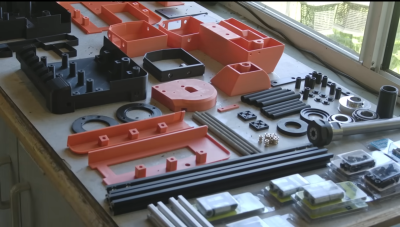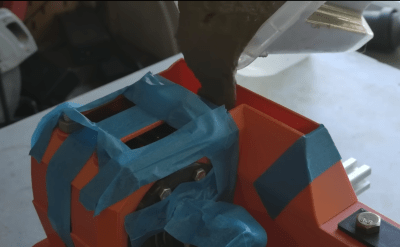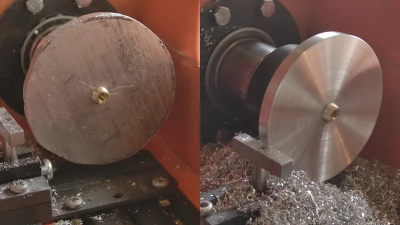
[Chris Borge] has spent the last few years creating some interesting 3D printed tools and recently has updated their 3D printable lathe design to make a few improvements. The idea was to 3D print the outer casing of the lathe in two parts, adding structural parts where needed to bolt on motors and tool holders, and then fill the whole thing with concrete for strength and rigidity.

The printed base is initially held together with two lengths of studding, and a pile of bolts are passed through from below, mating with t-nuts on the top. 2020 extrusion is used for the motor mount. The headstock is held on with four thread rods inserted into coupling nuts in the base. The headstock unit is assembled separately, but similarly; 3D printed outer shell and long lengths of studding and bolts to hold it together. Decent-sized tapered roller bearings make an appearance, as some areas of a machine tool really cannot be skrimped. [Chris] explains that the headstock is separate because this part is most likely to fail, so it is removable, allowing it to be replaced.


Once together, the whole assembly is filled with runny concrete and set aside to cure. Before fully curing, the top surfaces are scraped flat to remove excess concrete so the top covers will fit. A belt-driven motor is fitted, with associated control electronics, and then it’s time to talk tooling. The first tool shown is a simple T-shaped rest, used with a hand tool known as a ‘graver.’ This is more likely to be used on a wood lathe, but we reckon you could about get away with it if you’re really careful with aluminium or perhaps brass. An adjustable rest was made using a few simple pieces (in steel!) and held in a short length of 2020 extrusion in a manner that makes it adjustable, albeit not shown in this video. Finally, a reasonable torture test is demonstrated, comprising a rough-cut aluminium disk screwed to a threaded carrier. This was tidied up to make it nice and round and clean up its surfaces. The lathe survived, only melting the 3D printed motor pulley, which, as they say, should not have been a 3D printed part when metal parts are so easy to acquire! If you want to build one for yourself, then everything you need is here, but like with projects of this type, more development is still needed to overcome a few shortcomings. Check out [Chris]’s channel for many more interesting ideas!
We’ve seen a few of [Chris]’s other 3D-printed tools, like this neat fractal vice for odd-shaped objects. We like tiny tool hacks; after all, when you’re making small things, you don’t need full-sized tools.
Thanks to [CJay] for the tip!
No comments:
Post a Comment